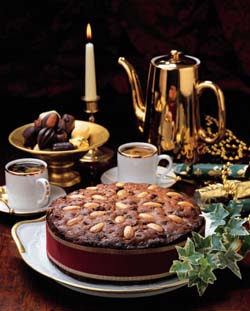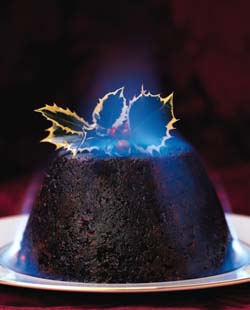A Taste of Christmas
by Dawn Copeman
 If there is one time of year when we forget all about
healthy eating and eating in moderation, it is Christmas. Many
people in Britain start buying extra food for Christmas from the
beginning of autumn: a box of chocolates here, a tin of biscuits
there, in preparation for the one time of year when far more food
is bought and cooked than could ever be eaten. If there is one time of year when we forget all about
healthy eating and eating in moderation, it is Christmas. Many
people in Britain start buying extra food for Christmas from the
beginning of autumn: a box of chocolates here, a tin of biscuits
there, in preparation for the one time of year when far more food
is bought and cooked than could ever be eaten.
Whilst Britons are tempted by an increasing array of Christmas
foods - such as panetone, stollen and lebkuchen - the staples of a
British Christmas are still mince pies, Christmas cake, Christmas
pudding and a sumptuous roast lunch.
Turkey is still the most popular main course for the lunch,
served with either bread sauce or cranberry sauce and accompanied
by roast potatoes, roast parsnips, sprouts, chestnuts and
carrots. But in recent years goose has made a comeback, and duck
is also becoming more popular. The key to all these dishes, the
thing that makes them a Christmas dish rather than an average
Sunday roast, is the stuffing. A Christmas roast must look and
taste fantastic.
In many British households it is the custom to also roast a pork,
ham or beef joint to accompany the fowl course. It is usual for
the accompanying roast meats to be cooked the day before and
served cold on Christmas Day.
After the lunch comes the Christmas pudding, which is normally
covered in brandy and set alight before being brought to the
table. Christmas pudding evolved from the 14th century's plum
porridge or frumenty, a dish that was eaten following the
traditional fasting on Christmas Eve.
Originally, frumenty consisted of porridge, scraps of meat, root
vegetables and dried fruits. Over time, spices and honey were
included, and in the late 16th century, breadcrumbs, eggs and
spirits were added. This dish could no longer be heated in a
porridge pan and could no longer really even be called porridge,
so the name changed to plum pudding and the mixture was placed in
a cloth, which was then tied up and boiled for several hours
until cooked.
 In 1664, the Puritans under Cromwell not only
banned the celebration of Christmas but also the eating of Plum
Pudding, mainly because of the richness of its ingredients. King
George I overturned this ban in 1714, and by then the meat was
omitted in favour of more dried fruits and spices. Yet it did not
become a popular tradition in England until the Victorian era,
when Prince Albert, who instigated many of our Christmas
traditions, re-introduced it as a staple of the Christmas feast.
By this time the root vegetables had gone too, although some
recipes still include a carrot. In 1664, the Puritans under Cromwell not only
banned the celebration of Christmas but also the eating of Plum
Pudding, mainly because of the richness of its ingredients. King
George I overturned this ban in 1714, and by then the meat was
omitted in favour of more dried fruits and spices. Yet it did not
become a popular tradition in England until the Victorian era,
when Prince Albert, who instigated many of our Christmas
traditions, re-introduced it as a staple of the Christmas feast.
By this time the root vegetables had gone too, although some
recipes still include a carrot.
If you want to make your own Christmas pudding (and I've included
a recipe below), then you need to do it soon. A Christmas pudding
takes around eight hours to cook and is normally made in Britain
on Stir-Up Sunday, the last Sunday before Advent. It is
considered good luck for every member of the family to stir the
pudding in a clockwise direction, while closing their eyes and
making a wish.
It is also traditional to include charms in your pudding. The
charms traditionally consist of a coin (representing health,
wealth and happiness), a thimble (representing a lucky life) and
a ring (representing marriage). Sainsbury's, a British
supermarket, tried to revive this tradition this year and spent
months locating sixpences to put into their puddings.
Unfortunately their plan fell foul of Health and Safety Laws, so
instead of being in the puddings, the coins will be in a
collector's card, which the host can place under a plate for a
guest to find. If you want to put charms in your puddings, wrap
them up in greaseproof paper so that they are easily identifiable
and remember to warn people that they are there.
Christmas cake is normally served at around teatime. A Christmas
Tea is traditionally very light -- cold meats, cheeses, pickles,
salad, sandwiches, Christmas cake and mince pies. (Although to be
fair, on Christmas day, the eating never stops from lunchtime to
bedtime: chocolates, crisps, biscuits, cakes, fruit, nuts, sweets
etc. Well, we do buy a lot of food -- so we do our best to eat it
all!)
Christmas cake was originally Twelfth Night Cake, a rich fruit
cake made to celebrate Epiphany. But the Puritans had removed
Twelfth Night from the church calendar and by the late 19th
Century it was becoming a night associated with mischief-making,
so Queen Victoria banned it as a feast day in 1870. The bakers,
not wishing to lose any money, simply iced the cakes they'd
already baked to represent a snowy scene and sold them as
Christmas cake instead.
Mince pies are not only eaten on Christmas Day, but during the
entire run up to Christmas. Originally the mince pie was a large
pie filled with minced meat such as ox tongue, beef or chicken,
eggs, raisins, sugar, orange and lemon peel, spices and brandy.
Over time the pies became smaller and as with Christmas pudding
the meat was gradually removed until we arrive at the modern
mincemeat which consists of dried fruit and spices which have
often been steeped in brandy.
I wish you all a very happy and hearty Christmas feast.
Recipes
Christmas pudding
1.5 cups currants
1.5 cups sultanas
1.5 cups raisins
1/2 cup mixed peel
1 cup flour
2 cups breadcrumbs
2 cups suet
1.5 cups brown sugar
1/2 teaspoon of mixed spice
1/4 teaspoon of nutmeg
1/3 cup walnut halves or chopped blanched almonds (optional)
Grated rind of one lemon or one orange.
4 eggs beaten
Quarter of a cup of brandy.
1/2 cup of milk.
- Put all the dry ingredients into a large mixing bowl and mix well.
- Add the eggs, brandy and milk to moisten the mixture.
- Pour into two greased and lined pudding bowls, cover with greaseproof paper secured
with sting and steam for 6 hours, topping up the water as it boils.
- Remove from pan, allow to go cold then cover with foil and store in a dry, cool
place.
- On Christmas Day -- steam for 2 hours. Serve with brandy butter, a.k.a. hard sauce
or custard.
Brandy Butter/Hard Sauce
1/2 cup butter
1/2 cup sifted confectioner's sugar
2 tablespoons brandy
- Cream the butter and sugar, add the brandy and beat until smooth.
- Put in the refrigerator until needed.
- Serve piled high in a dish.
Christmas cake
3 sticks butter
2 cups of brown sugar
6 eggs
4 cups flour
4 cups currants
4 cups sultanas
1 cup raisins
1 cup mixed peel
1/3 cup cherries
1 cup chopped almonds
1/2 teaspoon mixed spice
A pinch of salt
2 tablespoons treacle (or Golden Syrup)
1/2 cup brandy (optional)
Almond Paste
Royal Icing
- Cream the butter and sugar together, add the eggs one by one and beat until the
mixture is stiff.
- Stir in the remaining ingredients and mix well.
- Place mixture into a well greased, 9inch round cake tin, which has been lined
with greaseproof paper and bake for 6 and a half hours at 275°F, 140°C or
Gas Mark 1.
- Keep the cake in a in an airtight container for 2 - 3 weeks then cover with a
thick layer of almond paste.
- When the paste is set, cover with Royal Icing.
- When the icing has set, decorate as desired.
Miniature Mince Pies (makes 20)
8oz or 1 pack ready made rough puff pastry
2 cups mincemeat
Egg or milk to glaze
A little sugar
- Roll out the pastry and cut into 20 small and 20 large rounds.
- Place the small rounds on a greased baking sheet and place a teaspoonful of the
mincemeat filling in each.
- Damp the edges of the small rounds with water or milk and cover with the larger
rounds, sealing well.
- Brush with milk or beaten egg and sprinkle the sugar on top.
- Make a steam hole in the top of each pie then bake in the oven at 450°F,
230° or Gas Mark 8 for 10 - 15 minutes
Editor's Variation: Last Christmas I concocted a
delightful variation on the two-crusted mince pie: mince
tartlets. For this you'll need a miniature muffin pan (for 1-inch
"jewel" muffins). Cut out about 20 small rounds of ordinary pie
crust (packaged or homemade) for every 8 oz of mincemeat. Press
these rounds into the muffin pan. Fill with mincemeat and bake at
325°F for about 15 minutes or until the edges of the pie
crust turn golden brown. Top with brandied hard sauce if desired.
(If you have more muffin "holes" than rounds, fill the remaining
openings with a bit of water so that the pan won't burn.)
Dawn Copeman is a freelance writer and commercial writer who has had more than 100 articles published on travel, history, cookery, health and writing. She currently lives in Lincolnshire, where she is
working on her first fiction book. She started her career as a freelance
writer in 2004 and has been a contributing editor for several publications, including TimeTravel-Britain.com and Writing-World.com .
Article © 2005 Dawn Copeman
Images courtesy of BritainOnView.com
|
